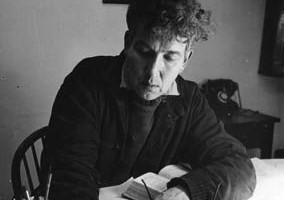
Modigliani painted some of the twentieth century’s most admired portraits and nudes, including his languorous dark-haired Reclining Nude (1917), and Sleeping Nude With Arms Open (Red Nude) (1917). He was born in Italy, and studied art in Florence and Venice before settling in Paris where, like most struggling artists, he lived in penury. He drank and took drugs, and over the years his health declined. After a series of wrenching love affairs, in early 1917 he was introduced to Jeanne Hebuterne, a fellow artist, and an artist’s model, and was instantly beguiled and smitten. She was equally taken, and they fell in love.
Her family did not approve of her becoming involved with a penniless artist, but there was little they could do. The couple moved to the south of France and lived in Nice, where their daughter Jeanne Modigliani was born in late 1918. From 1917-1919 Modigliani painted numerous elegant signature portraits of Jeanne Hebuterne, who became pregnant again. But Modigliani’s health was failing badly by then, and he contracted meningitis, and died in January 1920. Distraught, Jeanne Hebuterne was taken in by her parents, but the next day she threw herself from their fifth floor window.
The orphaned Jeanne Modigliani grew up knowing little of her parents’ fate until her adulthood, and ultimately published Modigliani: Man and Myth in 1958. She later passed on documents and previously unknown artworks by her mother to a French art critic on the proviso they not be made public until the year 2000, and in October of that year the paintings and drawings of Jeanne Hebuterne were exhibited for the first time.
Curiously, nine years after Hebuterne’s death, a similar incident took place in London, when American poet Laura Riding threw herself from an upper window after being rebuffed by a lover. Author T.E. Lawrence visited her in hospital, and wrote of it in a letter to his friend Charlotte Shaw, the wife of George Bernard Shaw. “She has broken her pelvis, and three bones in her spine, but will recover, they say, in six months. For love of an Irishman, Geoffrey Phibbs (who did not love her any more) she had thrown herself down four stories...”
The English poet Robert Graves comprised the third part of a triangle with Riding, and after she had thrown herself out, in despair he jumped too, from one storey down, but landed without serious harm.
He wrote his best-selling World War I memoir Goodbye to All That by Riding’s bedside as she recovered, and the pair departed England for the hilltop village of Deya, Mallorca, in Spain, where they lived together for the next ten years.
“Stop him,” Dallow cried: it wasn’t any good: he was at the edge, he was over: they couldn’t even hear a splash. It was as if he’d been withdrawn suddenly by a hand out of any existence - past or present, whipped away into zero - nothing.
- Grahame Greene, Brighton Rock
From my book Dead Famous: Deaths of the Famous and Famous Deaths.



